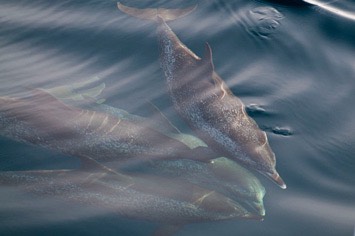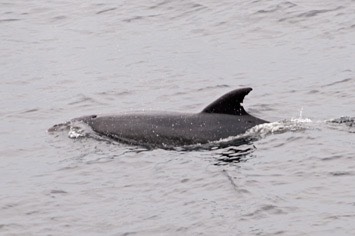Two trips in the waters off the Republic of Congo have given us many sightings of dolphins and whales, but one of our most spectacular encounters was of a blue marlin (Makaira nigricans) hunting a dorado (Coryphaena hyppurus). Marlin are very fast fish and they don't easily give up during a chase. Early one morning, when we saw a dorado skipping clear of the water several times with lots of swirling splashes underneath, we knew that we were witnessing a hunt by one of the big billfish. And sure enough, a marlin shot out from the water and managed to skewer the dorado, before shaking it off and repeating the same procedure again and again. In the end, the dorado was sufficiently stunned for the marlin to simply pick it out of the water and devour it for breakfast.








In the deeper waters off the shelf edge we came across several large groups of common dolphins, some of which happily approached our vessel to bow-ride. Both species of common dolphin, the long- and short-beaked common dolphin, can be found in Congolese waters. Separating them is not straight forward, but looking at the photos, we decided that those we had seen were long-beaked common dolphins (Delphinus capensis), as their overall colour scheme was very muted and some had very clear dark stripes from their faces down the side of their bellies towards their flukes. The young calves were also darker than the typically pale short-beaked common dolphin calves.







Atlantic spotted dolphins (Stenella frontalis) are inquisitive animals, often happy to approach vessels and bow-ride, and we had some great views of these pretty dolphins. Calves and juveniles are more uniformly grey, but as they grow older, they acquire more and more white spots, until they can be almost white.





In shallow inshore waters, bottlenose dolphins (Tursiops truncatus) are a common sight. These large, robust dolphins are all grey with paler bellies, but most of them tended to remain aloof and ignore us. Their behaviour can be quite spectacular, often with two or more animals jumping high over the top of each other! Some that came closer to the vessel were very well marked with rake marks or bits missing from their dorsal fins, making it possible to identify individuals. These old battle wounds are acquired through fighting with each other or sometimes from attacks by ocean predators.




One of the more unusual sightings we had was of a group of orcas, or killer whales (Orcinus orca). Although orcas are found all around the world, not many records exist from the tropical waters of West Africa, making this sighting all the more special. Orcas tend to be either fish eaters or fearsome predators of other marine mammals. It seems likely that these guys are whale and dolphin killers.


Other species we have seen in Congolese waters include short-finned pilot whale (Globicephala macrorhunchus), dwarf sperm whale (Kogia sima) and sei whale as well as Olive Ridley (Lepidochelys olivacea) and other unidentified turtles.
The bird life of West Africa is outstandingly diverse, and frequently land birds stray offshore in strong winds or during their migration, ending up seeking shelter on our ship. Visitors have included pied crows, paradise flycatchers and swifts. Seabirds seen regularly include various tern species, Cory's shearwaters, petrels and even an exhausted brown noddie!

